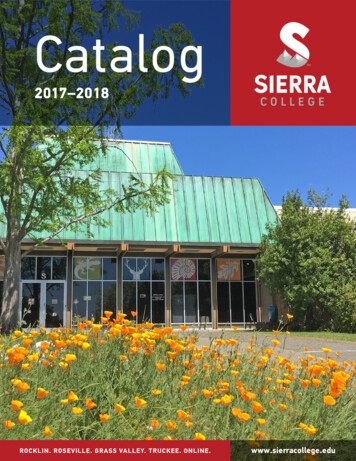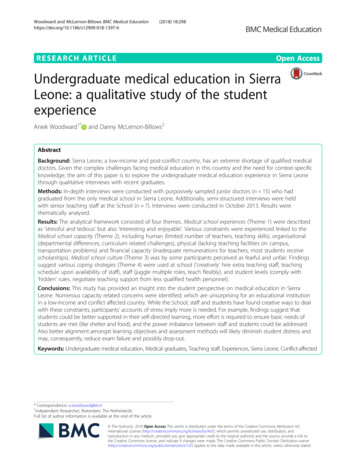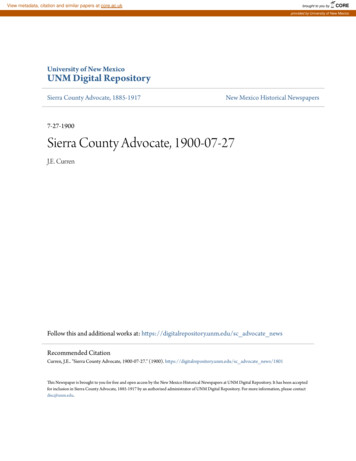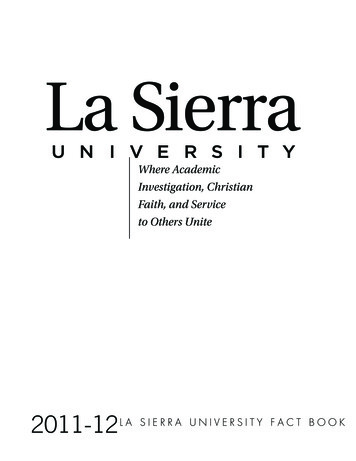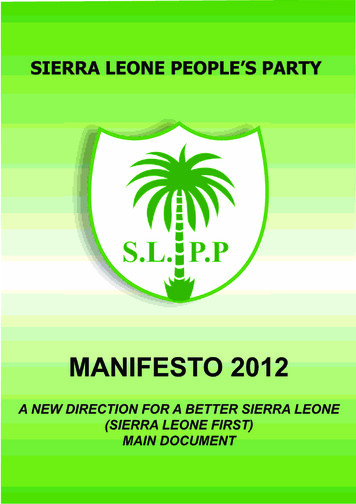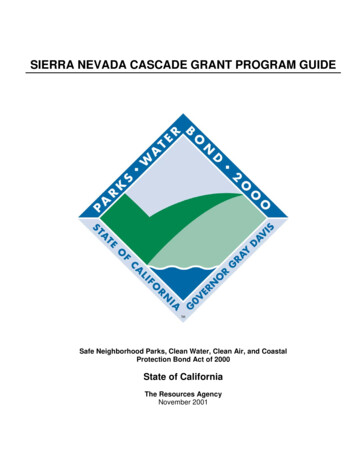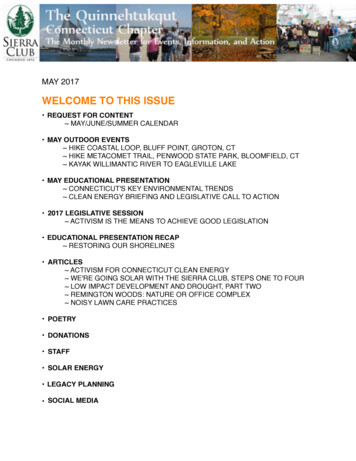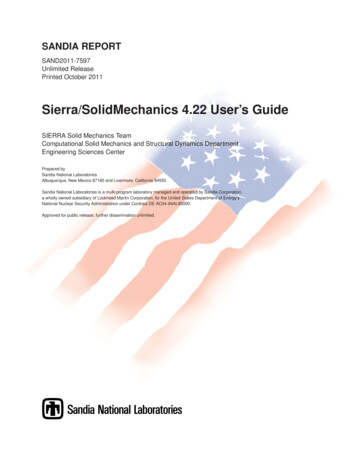
Transcription
SANDIA REPORTSAND2011-7597Unlimited ReleasePrinted October 2011Sierra/SolidMechanics 4.22 User’s GuideSIERRA Solid Mechanics TeamComputational Solid Mechanics and Structural Dynamics DepartmentEngineering Sciences CenterPrepared bySandia National LaboratoriesAlbuquerque, New Mexico 87185 and Livermore, California 94550Sandia National Laboratories is a multi-program laboratory managed and operated by Sandia Corporation,a wholly owned subsidiary of Lockheed Martin Corporation, for the United States Department of Energy’sNational Nuclear Security Administration under Contract DE-AC04-94AL85000.Approved for public release; further dissemination unlimited.
Issued by Sandia National Laboratories, operated for the United States Department of Energyby Sandia Corporation.NOTICE: This report was prepared as an account of work sponsored by an agency of the UnitedStates Government. Neither the United States Government, nor any agency thereof, nor anyof their employees, nor any of their contractors, subcontractors, or their employees, make anywarranty, express or implied, or assume any legal liability or responsibility for the accuracy,completeness, or usefulness of any information, apparatus, product, or process disclosed, or represent that its use would not infringe privately owned rights. Reference herein to any specificcommercial product, process, or service by trade name, trademark, manufacturer, or otherwise,does not necessarily constitute or imply its endorsement, recommendation, or favoring by theUnited States Government, any agency thereof, or any of their contractors or subcontractors.The views and opinions expressed herein do not necessarily state or reflect those of the UnitedStates Government, any agency thereof, or any of their contractors.Printed in the United States of America. This report has been reproduced directly from the bestavailable copy.Available to DOE and DOE contractors fromU.S. Department of EnergyOffice of Scientific and Technical InformationP.O. Box 62Oak Ridge, TN 37831Telephone:Facsimile:E-Mail:Online ordering:(865) 576-8401(865) /bridgeAvailable to the public fromU.S. Department of CommerceNational Technical Information Service5285 Port Royal RdSpringfield, VA 22161(800) 553-6847(703) v/help/ordermethods.asp?loc 7-4-0#onlineNT OF EMENRTGYERDEPATelephone:Facsimile:E-Mail:Online ordering: EDERU NITIC A STA TES OF AM2
SAND2011-7597Unlimited ReleasePrinted October 2011Sierra/SolidMechanics 4.22 User’s GuideSIERRA Solid Mechanics TeamComputational Solid Mechanics and Structural Dynamics DepartmentEngineering Sciences CenterSandia National LaboratoriesBox 5800Albuquerque, NM 87185-0380AbstractSierra/SolidMechanics (Sierra/SM) is a Lagrangian, three-dimensional code for the analysis of solids andstructures. It provides capabilities for explicit dynamic and implicit quasistatic and dynamic analyses. Theexplicit dynamics capabilities allow for the efficient and robust solution of models subjected to large, suddenly applied loads. For implicit problems, Sierra/SM uses a multi-level iterative solver, which enables itto effectively solve problems with large deformations, nonlinear material behavior, and contact. Sierra/SMhas a versatile library of continuum and structural elements, and an extensive library of material models.The code is written for parallel computing environments, and it allows for scalable solutions of very largeproblems for both implicit and explicit analyses. It is built on the SIERRA Framework, which allows forcoupling with other SIERRA mechanics codes. This document describes the functionality and input structure for Sierra/SM.3
AcknowledgmentsThis document is the result of the collective effort of a number of individuals. The current development team responsible for Adagio and Presto, the SIERRA Solid Mechanics codes, includes Nathan K. Crane, Martin W. Heinstein, Alex J. Lindblad, David J. Littlewood, Kyran D.Mish, Kendall H. Pierson, Vicki L. Porter, Nathaniel S. Roehrig, Timothy R. Shelton, Gregory D.Sjaardema, Benjamin W. Spencer, Jesse D. Thomas, and Michael G. Veilleux. This document iswritten and maintained by this team.Outside the core development team, there are number of other individuals who have contributedto this manual. Nicole L. Breivik, J. Franklin Dempsey, Jeffery D. Gruda, and Chi S. (David) Lohave provided valuable input from the user community as Product Managers.Many others have contributed to this document, either directly or indirectly. These include, butare not limited to Manoj K. Bhardwaj, James V. Cox, Jason D. Hales, Arne S. Gullerud, DanielC. Hammerand, J. Richard Koteras, Jakob T. Ostien, Rhonda K. Reinert, William M. Scherzinger,and Gerald W. Wellman.4
Sierra/SM 4.22 Release NotesFollowing is a list of new features and syntax changes made to Sierra/SM since the 4.20 release.The separate Adagio and Presto manuals have been discontinued in favor of a unified Sierra/SMmanual that documents features for both explicit and implicit analyses. See Section 1.3.7.Piecewise analytic functions can now be defined. See Section 2.1.5.Default values have been defined and documented for many of the implicit solver commands. SeeChapter 3.5.The solver will now report convergence if the residual norm reaches a value that is approximatelyzero to within the machine precision tolerance for the problem. This convergence will occur evenif the relative residual is not reached and can allow correct handling of load-steps with nominallyzero external load. See Section 4.2.1.Solver convergence can now be based on an energy-based residual and residual reference. Theseenergy norms are useful for evaluating the residual for problems that include combinations offorces and moments. See Section 4.2.1.New options are provided to control the FETI solver’s linear system conditioning to improve CGconvergence. See Section 4.3.2.Thermal strain calculations have been added to one-dimensional elements. See Section 5.1.3.1.A fiber shell material model that adds plate-bending response to the existing fiber membrane modelhas been implemented and documented. See Section 5.2.23.All Strumento material models have either been replaced by models in the LAME library or, in afew cases, removed. As a result, the USE STRUMENTO LAME command has been removed. SeeSection 6.2.Documentation has been added for fully-integrated solid elements. See Section 6.2.1.An analytic, through-thickness integration scheme is now available for elastic shells. See Section 6.2.4.The SHELL DRILLING STIFFNESS command has been removed from the FULL TANGENTPRECONDITIONER command block. It is now recommended to specify physical drilling stiffnessin the shell section. See Section 6.2.4.An option has been added to the element death capability to kill elements based on proximity toother nodes or elements. See Section 6.5.4.85
Parts of the input mesh can now be translated or rotated at the beginning of the run through commands in the input file. See Section 7.2.Documentation has been added for periodic boundary conditions. See Section 7.4.5.Pressure boundary conditions can now be applied to elements that have been converted to particles.See Section 7.6.1.A velocity damping coefficient can now be applied to pressure boundary conditions. See Section 7.6.1.2.Contact surfaces can now be subdivided based on normal directions. See Section 8.2.4Examples on how contact surfaces are defined using block skinning, side sets, lofted geometry,and element death have been added. See Section 8.2.7.Documentation has been added for general analytic rigid contact surfaces. See Section 8.2.8.1.A velocity-dependent Coulomb friction model is now available for explicit dynamics. See Section 8.3.0.6.The lofted radius of beam elements for contact can now optionally be specified. Additionally, theshapes of lofted beams and the shapes and radii of lofted particles can be specified by elementblock. See Section 8.5.8.The name of the SHELL LOFTING command block for contact has been changed to SURFACEOPTIONS. See Section 8.5.8.The ACTIVE PERIODS command can now be used to selectively enable contact by time period.See Section 8.6.Additional user output options for operating on integration point quantities are now available. Forexample, element quantities for output can be computed based on an average of integration pointquantities. See Section 9.2.2.2.Variables can now be interpolated to face variables on a different mesh. In addition, the timederivative of an interpolated variable can also be computed. See Section 9.7.The global angular momentum of a problem can now be requested as a output variable. SeeSection 9.9.The tables of state variable output from material models have been updated to include more complete listings for many models. See Section 9.9.2.6
Sierra/SM 4.22 Known IssuesSection 3.4.1.2: When using explicit control modes, the Lanczos and power method time stepestimators can not yet be used with problems that have contact, rigid bodies, blocks in the finemesh that are not controlled by the coarse mesh, or coarse elements that contain no fine nodes.Section 4.3: Deactivation of element blocks (see Section 6.1.5.9) does not currently work in conjunction with the full tangent preconditioner in Adagio. To use this capability, one of the nodalpreconditioners must be used.Section 6.2.1: For problems with large rotations, the hourglass energies are known to spike exponentially with increases in total rotation. This behavior is observed for both midpoint and stronglyobjective strain incrementation, and for both incremental and total hourglass formulations. Thelarge rotation issue is a known limitation in solid mechanics for all non-hyperelastic material models.Section 6.2.11: For problems with rotations, the sph algorithm generates rotational spring likeforces on the boundary because of known deficiencies in the algorithm in distinguishing betweenrigid body rotation and deformation. The sph algorithm does not conserve rotational or angularmomentum.Section 6.2.12: Superelements are not compatible with several modeling capabilities. They cannotbe used with element death. They cannot be used with node-based, power method, or Lanczoscritical time step estimation methods. They are also not compatible with some preconditioners(such as FETI) for implicit solutions.Section 7.4.2.2: If a prescribed displacement with the CYLINDRICAL AXIS option is applied tonodes that fall on the axis, it will have no effect. Separate boundary conditions should be appliedto those nodes to fix them in the plane normal to the axis.Section 7.4.3.2: If a prescribed velocity with the CYLINDRICAL AXIS option is applied to nodesthat fall on the axis, it will have no effect. Separate boundary conditions should be applied to thosenodes to fix them in the plane normal to the axis.Section 8.5.9: Attempting to use GLOBAL SEARCH INCREMENT with a value greater than 1, especially in a problem that contains shells and/or restart, will, in most cases, cause code failure. AGLOBAL SEARCH INCREMENT value greater than 1 will, under the best circumstances, give onlya marginal improvement in speed.Section 9.4: User defined variables (see Section 11.2.4) are not currently supported with heartbeatoutput.7
Section 10.2: Currently, the J-Integral evaluation capability is based on assumptions of elastostatics and a stationary crack, and is only implemented for uniform gradient hex elements.8
Contents1Introduction371.1Document Overview . . . . . . . . . . . . . . . . . . . . . . . . . . . . . . . . . 381.2Overall Input Structure . . . . . . . . . . . . . . . . . . . . . . . . . . . . . . . . 401.3Conventions for Command Descriptions . . . . . . . . . . . . . . . . . . . . . . . 431.41.3.1Key Words . . . . . . . . . . . . . . . . . . . . . . . . . . . . . . . . . . 431.3.2User-Specified Input . . . . . . . . . . . . . . . . . . . . . . . . . . . . . 431.3.3Optional Input . . . . . . . . . . . . . . . . . . . . . . . . . . . . . . . . 441.3.4Default Values . . . . . . . . . . . . . . . . . . . . . . . . . . . . . . . . 441.3.5Multiple Options for Values . . . . . . . . . . . . . . . . . . . . . . . . . 441.3.6Known Issues and Warnings . . . . . . . . . . . . . . . . . . . . . . . . . 451.3.7Commands Applicable to Only Explicit or Implicit Analyses . . . . . . . . 45Style Guidelines . . . . . . . . . . . . . . . . . . . . . . . . . . . . . . . . . . . . 471.4.1Comments . . . . . . . . . . . . . . . . . . . . . . . . . . . . . . . . . . 471.4.2Continuation Lines . . . . . . . . . . . . . . . . . . . . . . . . . . . . . . 471.4.3Case . . . . . . . . . . . . . . . . . . . . . . . . . . . . . . . . . . . . . . 471.4.4Commas and Tabs . . . . . . . . . . . . . . . . . . . . . . . . . . . . . . 471.4.5Blank Spaces . . . . . . . . . . . . . . . . . . . . . . . . . . . . . . . . . 481.4.6General Format of the Command Lines . . . . . . . . . . . . . . . . . . . 481.4.7Delimiters . . . . . . . . . . . . . . . . . . . . . . . . . . . . . . . . . . . 491.4.8Order of Commands . . . . . . . . . . . . . . . . . . . . . . . . . . . . . 491.4.9Abbreviated END Specifications . . . . . . . . . . . . . . . . . . . . . . . 491.4.10 Indentation . . . . . . . . . . . . . . . . . . . . . . . . . . . . . . . . . . 501.4.11 Including Files . . . . . . . . . . . . . . . . . . . . . . . . . . . . . . . . 501.5Exodus II Database Naming Conventions . . . . . . . . . . . . . . . . . . . . . . 519
21.6Major Scope Definitions for an Input File . . . . . . . . . . . . . . . . . . . . . . 521.7Input/Output Files . . . . . . . . . . . . . . . . . . . . . . . . . . . . . . . . . . . 541.8Obtaining Support . . . . . . . . . . . . . . . . . . . . . . . . . . . . . . . . . . . 561.9References . . . . . . . . . . . . . . . . . . . . . . . . . . . . . . . . . . . . . . . 57General Commands2.12.2SIERRA Scope . . . . . . . . . . . . . . . . . . . . . . . . . . . . . . . . . . . . 592.1.1SIERRA Command Block . . . . . . . . . . . . . . . . . . . . . . . . . . 592.1.2Title . . . . . . . . . . . . . . . . . . . . . . . . . . . . . . . . . . . . . . 602.1.3Restart Control . . . . . . . . . . . . . . . . . . . . . . . . . . . . . . . . 602.1.3.1Restart Time . . . . . . . . . . . . . . . . . . . . . . . . . . . . 612.1.3.2Automatic Restart . . . . . . . . . . . . . . . . . . . . . . . . . 612.1.4User Subroutine Identification . . . . . . . . . . . . . . . . . . . . . . . . 612.1.5Functions . . . . . . . . . . . . . . . . . . . . . . . . . . . . . . . . . . . 622.1.6Axes, Directions, and Points . . . . . . . . . . . . . . . . . . . . . . . . . 672.1.7Orientation . . . . . . . . . . . . . . . . . . . . . . . . . . . . . . . . . . 692.1.8Coordinate System Block Command . . . . . . . . . . . . . . . . . . . . . 732.1.9Define Coordinate System Line Command . . . . . . . . . . . . . . . . . 75Procedure and Region . . . . . . . . . . . . . . . . . . . . . . . . . . . . . . . . . 762.2.1Procedure . . . . . . . . . . . . . . . . . . . . . . . . . . . . . . . . . . . 772.2.2Time Control . . . . . . . . . . . . . . . . . . . . . . . . . . . . . . . . . 772.2.33592.2.2.1Explicit Dynamic Time Control . . . . . . . . . . . . . . . . . . 772.2.2.2Implicit Time Control . . . . . . . . . . . . . . . . . . . . . . . 78Region . . . . . . . . . . . . . . . . . . . . . . . . . . . . . . . . . . . . 782.3Use Finite Element Model . . . . . . . . . . . . . . . . . . . . . . . . . . . . . . 802.4Element Distortion Metrics . . . . . . . . . . . . . . . . . . . . . . . . . . . . . . 812.5Activation/Deactivation of Functionality . . . . . . . . . . . . . . . . . . . . . . . 832.6Error Recovery . . . . . . . . . . . . . . . . . . . . . . . . . . . . . . . . . . . . 832.7Manual Job Control . . . . . . . . . . . . . . . . . . . . . . . . . . . . . . . . . . 84Explicit Dynamic Time Step Control3.186Procedure Time Control . . . . . . . . . . . . . . . . . . . . . . . . . . . . . . . . 873.1.1Command Blocks for Time Control and Time Stepping . . . . . . . . . . . 8910
3.23.1.2Initial Time Step . . . . . . . . . . . . . . . . . . . . . . . . . . . . . . . 913.1.3Time Step Scale Factor . . . . . . . . . . . . . . . . . . . . . . . . . . . . 913.1.4Time Step Increase Factor . . . . . . . . . . . . . . . . . . . . . . . . . . 913.1.5Step Interval . . . . . . . . . . . . . . . . . . . . . . . . . . . . . . . . . 913.1.6Example . . . . . . . . . . . . . . . . . . . . . . . . . . . . . . . . . . . 92Other Critical Time Step Methods . . . . . . . . . . . . . . . . . . . . . . . . . . 943.2.13.2.23.2.3Lanczos Method . . . . . . . . . . . . . . . . . . . . . . . . . . . . . . . 953.2.1.1Lanczos Method with Constant Time Steps . . . . . . . . . . . . 963.2.1.2Controls for Lanczos Method . . . . . . . . . . . . . . . . . . . 993.2.1.3Scale Factor for Lanczos Method . . . . . . . . . . . . . . . . . 1003.2.1.4Accuracy of Eigenvalue Estimate . . . . . . . . . . . . . . . . . 1013.2.1.5Lanczos Parameters Command Block . . . . . . . . . . . . . . . 102Power Method . . . . . . . . . . . . . . . . . . . . . . . . . . . . . . . . 1053.2.2.1Power Method with Constant Time Steps . . . . . . . . . . . . . 1063.2.2.2Controls for Power Method . . . . . . . . . . . . . . . . . . . . 1073.2.2.3Scale Factor for Power Method . . . . . . . . . . . . . . . . . . 1083.2.2.4Accuracy of Eigenvalue Estimate . . . . . . . . . . . . . . . . . 1083.2.2.5Power Method Parameters Command Block . . . . . . . . . . . 109Node-Based Method . . . . . . . . . . . . . . . . . . . . . . . . . . . . . 1113.2.3.13.33.4Node-Based Parameters Command Block . . . . . . . . . . . . 112Mass Scaling . . . . . . . . . . . . . . . . . . . . . . . . . . . . . . . . . . . . . 1133.3.1What is Mass Scaling? . . . . . . . . . . . . . . . . . . . . . . . . . . . . 1133.3.2Mass Scaling Command Block . . . . . . . . . . . . . . . . . . . . . . . . 1143.3.3Node Set Commands . . . . . . . . . . . . . . . . . . . . . . . . . . . . . 1153.3.3.1Mass Scaling Commands . . . . . . . . . . . . . . . . . . . . . 1153.3.3.2Additional Commands . . . . . . . . . . . . . . . . . . . . . . . 116Explicit Control Modes . . . . . . . . . . . . . . . . . . . . . . . . . . . . . . . . 1163.4.1Control Modes Region . . . . . . . . . . . . . . . . . . . . . . . . . . . . 1173.4.1.1Model Setup Commands . . . . . . . . . . . . . . . . . . . . . 1183.4.1.2Time Step Control Commands . . . . . . . . . . . . . . . . . . 1193.4.1.3Mass Scaling Commands . . . . . . . . . . . . . . . . . . . . . 1203.4.1.4Damping Commands . . . . . . . . . . . . . . . . . . . . . . . 12111
3.543.4.1.5Kinematic Boundary Condition Commands . . . . . . . . . . . 1213.4.1.6Output Commands . . . . . . . . . . . . . . . . . . . . . . . . . 121References . . . . . . . . . . . . . . . . . . . . . . . . . . . . . . . . . . . . . . . 123Implicit Solver, Time Step, and Dynamics1244.1Multilevel Solver . . . . . . . . . . . . . . . . . . . . . . . . . . . . . . . . . . . 1264.2Conjugate Gradient Solver . . . . . . . . . . . . . . . . . . . . . . . . . . . . . . 1304.34.44.54.64.2.1Convergence Commands . . . . . . . . . . . . . . . . . . . . . . . . . . . 1324.2.2Preconditioner Commands . . . . . . . . . . . . . . . . . . . . . . . . . . 1344.2.3Line Search Command . . . . . . . . . . . . . . . . . . . . . . . . . . . . 1374.2.4Diagnostic Output Commands . . . . . . . . . . . . . . . . . . . . . . . . 1384.2.5CG Algorithm Commands . . . . . . . . . . . . . . . . . . . . . . . . . . 139Full Tangent Preconditioner . . . . . . . . . . . . . . . . . . . . . . . . . . . . . . 1414.3.1Solver Selection Commands . . . . . . . . . . . . . . . . . . . . . . . . . 1424.3.2Matrix Formation Commands . . . . . . . . . . . . . . . . . . . . . . . . 1434.3.3Reset and Iteration Commands . . . . . . . . . . . . . . . . . . . . . . . . 1454.3.4Fall-Back Strategy Commands . . . . . . . . . . . . . . . . . . . . . . . . 147FETI Equation Solver . . . . . . . . . . . . . . . . . . . . . . . . . . . . . . . . . 1494.4.1Convergence Commands . . . . . . . . . . . . . . . . . . . . . . . . . . . 1504.4.2Memory Usage Commands . . . . . . . . . . . . . . . . . . . . . . . . . . 1504.4.3Solver Commands . . . . . . . . . . . . . . . . . . . . . . . . . . . . . . 151Control Contact . . . . . . . . . . . . . . . . . . . . . . . . . . . . . . . . . . . . 1534.5.1Convergence Commands . . . . . . . . . . . . . . . . . . . . . . . . . . . 1574.5.2Level Selection Command . . . . . . . . . . . . . . . . . . . . . . . . . . 1584.5.3Diagnostic Output Commands . . . . . . . . . . . . . . . . . . . . . . . . 1594.5.4Augmented Lagrange Enforcement Commands . . . . . . . . . . . . . . . 1594.5.4.1Augmented Lagrange Adaptive Penalty Commands . . . . . . . 1604.5.4.2Augmented Lagrange Tolerance and Convergence Options . . . 1604.5.4.3Augmented Lagrange Miscellaneous Options . . . . . . . . . . 161Control Stiffness . . . . . . . . . . . . . . . . . . . . . . . . . . . . . . . . . . . 1624.6.1Convergence Commands . . . . . . . . . . . . . . . . . . . . . . . . . . . 1684.6.2Level Selection Command . . . . . . . . . . . . . . . . . . . . . . . . . . 1704.6.3Diagnostic Output Commands . . . . . . . . . . . . . . . . . . . . . . . . 17112
4.74.8Control Failure . . . . . . . . . . . . . . . . . . . . . . . . . . . . . . . . . . . . 1724.7.1Convergence Command . . . . . . . . . . . . . . . . . . . . . . . . . . . 1724.7.2Level Selection Command . . . . . . . . . . . . . . . . . . . . . . . . . . 1734.7.3Diagnostic Output Commands . . . . . . . . . . . . . . . . . . . . . . . . 173Control Modes . . . . . . . . . . . . . . . . . . . . . . . . . . . . . . . . . . . . 1744.8.14.9Control Modes Region . . . . . . . . . . . . . . . . . . . . . . . . . . . . 1754.8.1.1Model Setup Commands . . . . . . . . . . . . . . . . . . . . . 1764.8.1.2Solver Commands . . . . . . . . . . . . . . . . . . . . . . . . . 1764.8.1.3Kinematic Boundary Condition Commands . . . . . . . . . . . 177Predictors . . . . . . . . . . . . . . . . . . . . . . . . . . . . . . . . . . . . . . . 1784.9.14.9.2Loadstep Predictor . . . . . . . . . . . . . . . . . . . . . . . . . . . . . . 1784.9.1.1Predictor Type . . . . . . . . . . . . . . . . . . . . . . . . . . . 1784.9.1.2Scale Factor . . . . . . . . . . . . . . . . . . . . . . . . . . . . 1794.9.1.3Slip Scale Factor . . . . . . . . . . . . . . . . . . . . . . . . . . 179Level Predictor . . . . . . . . . . . . . . . . . . . . . . . . . . . . . . . . 1804.10 JAS3D Compatibility Mode . . . . . . . . . . . . . . . . . . . . . . . . . . . . . 1814.11 Time Step Control . . . . . . . . . . . . . . . . . . . . . . . . . . . . . . . . . . . 1824.11.1 Command Blocks for Time Control and Time Stepping . . . . . . . . . . . 1824.11.1.1 Time Increment . . . . . . . . . . . . . . . . . . . . . . . . . . 1844.11.1.2 Number of Time Steps . . . . . . . . . . . . . . . . . . . . . . . 1844.11.1.3 Time Increment Function . . . . . . . . . . . . . . . . . . . . . 1844.11.2 Adaptive Time Stepping . . . . . . . . . . . . . . . . . . . . . . . . . . . 1854.11.2.1 Method . . . . . . . . . . . . . . . . . . . . . . . . . . . . . . . 1864.11.2.2 Target Iterations . . . . . . . . . . . . . . . . . . . . . . . . . . 1864.11.2.3 Iteration Window . . . . . . . . . . . . . . . . . . . . . . . . . 1864.11.2.4 Cutback Factor . . . . . . . . . . . . . . . . . . . . . . . . . . . 1874.11.2.5 Growth Factor . . . . . . . . . . . . . . . . . . . . . . . . . . . 1874.11.2.6 Maximum Failure Cutbacks . . . . . . . . . . . . . . . . . . . . 1874.11.2.7 Maximum Multiplier . . . . . . . . . . . . . . . . . . . . . . . 1874.11.2.8 Minimum Multiplier . . . . . . . . . . . . . . . . . . . . . . . . 1884.11.2.9 Reset at New Period . . . . . . . . . . . . . . . . . . . . . . . . 1884.11.2.10 Active Periods . . . . . . . . . . . . . . . . . . . . . . . . . . . 18813
4.11.3 Time Control Example . . . . . . . . . . . . . . . . . . . . . . . . . . . . 1894.12 Implicit Dynamic Time Integration . . . . . . . . . . . . . . . . . . . . . . . . . . 1904.12.1 Implicit Dynamics . . . . . . . . . . . . . . . . . . . . . . . . . . . . . . 1904.12.1.1 Active Periods . . . . . . . . . . . . . . . . . . . . . . . . . . . 1904.12.1.2 Use HHT Integration . . . . . . . . . . . . . . . . . . . . . . . 1914.12.1.3 HHT Parameters . . . . . . . . . . . . . . . . . . . . . . . . . . 1914.12.1.4 Implicit Dynamic Adaptive Time Stepping . . . . . . . . . . . . 1914.13 References . . . . . . . . . . . . . . . . . . . . . . . . . . . . . . . . . . . . . . . 1935Materials5.15.2194General Material Commands . . . . . . . . . . . . . . . . . . . . . . . . . . . . . 1985.1.1Density Command . . . . . . . . . . . . . . . . . . . . . . . . . . . . . . 1985.1.2Biot’s Coefficient Command . . . . . . . . . . . . . . . . . . . . . . . . . 1985.1.3Thermal Strain Behavior . . . . . . . . . . . . . . . . . . . . . . . . . . . 1985.1.3.1Defining Thermal Strains . . . . . . . . . . . . . . . . . . . . . 1995.1.3.2Activating Thermal Strains . . . . . . . . . . . . . . . . . . . . 201Material Models . . . . . . . . . . . . . . . . . . . . . . . . . . . . . . . . . . . . 2025.2.1Elastic Model . . . . . . . . . . . . . . . . . . . . . . . . . . . . . . . . . 2025.2.2Thermoelastic Model . . . . . . . . . . . . . . . . . . . . . . . . . . . . . 2045.2.3Neo-Hookean Model . . . . . . . . . . . . . . . . . . . . . . . . . . . . . 2065.2.4Elastic Fracture Model . . . . . . . . . . . . . . . . . . . . . . . . . . . . 2085.2.5Elastic-Plastic Model . . . . . . . . . . . . . . . . . . . . . . . . . . . . . 2105.2.6Elastic-Plastic Power-Law Hardening Model . . . . . . . . . . . . . . . . 2125.2.7Ductile Fracture Model . . . . . . . . . . . . . . . . . . . . . . . . . . . . 2145.2.8Multilinear EP Hardening Model . . . . . . . . . . . . . . . . . . . . . . . 2165.2.9Multilinear EP Hardening Model with Failure . . . . . . . . . . . . . . . . 2185.2.10 Johnson-Cook Model . . . . . . . . . . . . . . . . . . . . . . . . . . . . . 2215.2.11 BCJ Model . . . . . . . . . . . . . . . . . . . . . . . . . . . . . . . . . . 2235.2.12 Power Law Creep . . . . . . . . . . . . . . . . . . . . . . . . . . . . . . . 2255.2.13 Soil and Crushable Foam Model . . . . . . . . . . . . . . . . . . . . . . . 2275.2.14 Karagozian and Case Concrete Model . . . . . . . . . . . . . . . . . . . . 2305.2.15 Foam Plasticity Model . . . . . . . . . . . . . . . . . . . . . . . . . . . . 2335.2.16 Low Density Foam Model . . . . . . . . . . . . . . . . . . . . . . . . . . 23614
5.2.17 Elastic Three-Dimensional Orthotropic Model . . . . . . . . . . . . . . . 2375.2.18 Wire Mesh Model . . . . . . . . . . . . . . . . . . . . . . . . . . . . . . 2405.2.19 Orthotropic Crush Model . . . . . . . . . . . . . . . . . . . . . . . . . . . 2425.2.20 Orthotropic Rate Model . . . . . . . . . . . . . . . . . . . . . . . . . . . 2455.2.21 Elastic Laminate Model . . . . . . . . . . . . . . . . . . . . . . . . . . . 2485.2.22 Fiber Membrane Model . . . . . . . . . . . . . . . . . . . . . . . . . . . 2515.2.23 Fiber Shell Model . . . . . . . . . . . . . . . . . . . . . . . . . . . . . . 2545.2.24 Incompressible Solid Model . . . . . . . . . . . . . . . . . . . . . . . . . 2565.2.25 Mooney-Rivlin Model . . . . . . . . . . . . . . . . . . . . . . . . . . . . 2595.2.26 NLVE 3D Orthotropic Model . . . . . . . . . . . . . . . . . . . . . . . . 2625.2.27 Stiff Elastic . . . . . . . . . . . . . . . . . . . . . . . . . . . . . . . . . . 2665.2.28 Swanson Model . . . . . . . . . . . . . . . . . . . . . . . . . . . . . . . . 2685.2.29 Viscoelastic Swanson Model . . . . . . . . . . . . . . . . . . . . . . . . . 2715.35.46Cohesive Zone Material Models . . . . . . . . . . . . . . . . . . . . . . . . . . . 2755.3.1Traction Decay . . . . . . . . . . . . . . . . . . . . . . . . . . . . . . . . 2755.3.2Tvergaard Hutchinson . . . . . . . . . . . . . . . . . . . . . . . . . . . . 2765.3.3Thouless Parmigiani . . . . . . . . . . . . . . . . . . . . . . . . . . . . . 2785.3.4Compliant Joint . . . . . . . . . . . . . . . . . . . . . . . . . . . . . . . . 280References . . . . . . . . . . . . . . . . . . . . . . . . . . . . . . . . . . . . . . . 281Elements6.1283Finite Element Model . . . . . . . . . . . . . . . . . . . . . . . . . . . . . . . . . 2846.1.1Identification of Mesh File . . . . . . . . . . . . . . . . . . . . . . . . . . 2876.1.2Alias . . . . . . . . . . . . . . . . . . . . . . . . . . . . . . . . . . . . . 2886.1.3Omit Block . . . . . . . . . . . . . . . . . . . . . . . . . . . . . . . . . . 2886.1.4Component Separator Character . . . . . . . . . . . . . . . . . . . . . . . 2886.1.5Descriptors of Element Blocks . . . . . . . . . . . . . . . . . . . . . . . . 2896.1.5.1Material Property . . . . . . . . . . . . . . . . . . . . . . . . . 2916.1.5.2Include All Blocks . . . . . . . . . . . . . . . . . . . . . . . . . 2916.1.5.3Remove Block . . . . . . . . . . . . . . . . . . . . . . . . . . . 2926.1.5.4Section . . . . . . . . . . . . . . . . . . . . . . . . . . . . . . . 2926.1.5.5Linear and Quadratic Bulk Viscosity . . . . . . . . . . . . . . . 2926.1.5.6Hourglass Control . . . . . . . . . . . . . . . . . . . . . . . . . 29215
6.26.1.5.7Effective Moduli Model . . . . . . . . . . . . . . . . . . . . . . 2946.1.5.8Element Numerical Formulation . . . . . . . . . . . . . . . . . 2956.1.5.9Activation/Deactivation of Element Blocks by Time . . . . . . . 296Element Sections . . . . . . . . . . . . . . . . . . . . . . . . . . . . . . . . . . . 2976.2.1Solid Section . . . . . . . . . . . . . . . . . . . . . . . . . . . . . . . . . 2976.2.2Cohesive Section . . . . . . . . . . . . . . . . . . . . . . . . . . . . . . . 3006.2.3Localization Section . . . . . . . . . . . . . . . . . . . . . . . . . . . . . 3016.2.4Shell Section . . . . . . . . . . . . . . . . . . . . . . . . . . . . . . . . . 3026.
Sierra/SM 4.22 Release Notes Following is a list of new features and syntax changes made to Sierra/SM since the 4.20 release. The separate Adagio and Presto manuals have been discontinued in favor of a unified Sierra/SM


